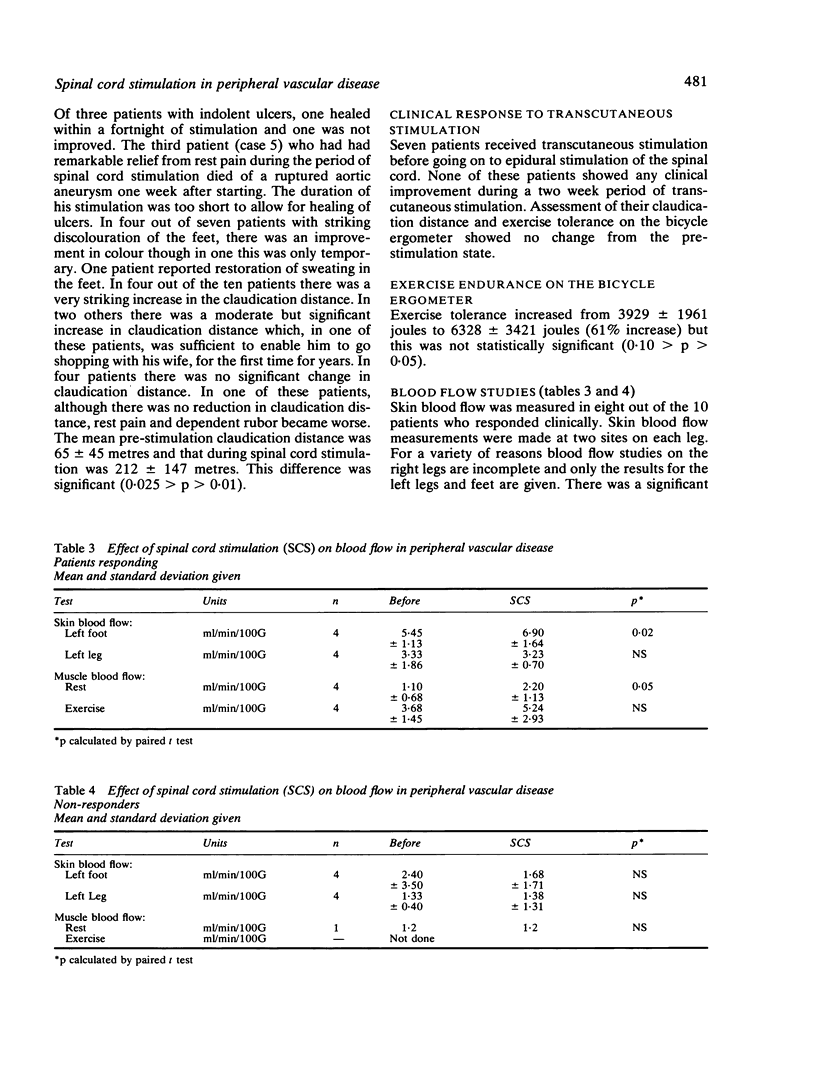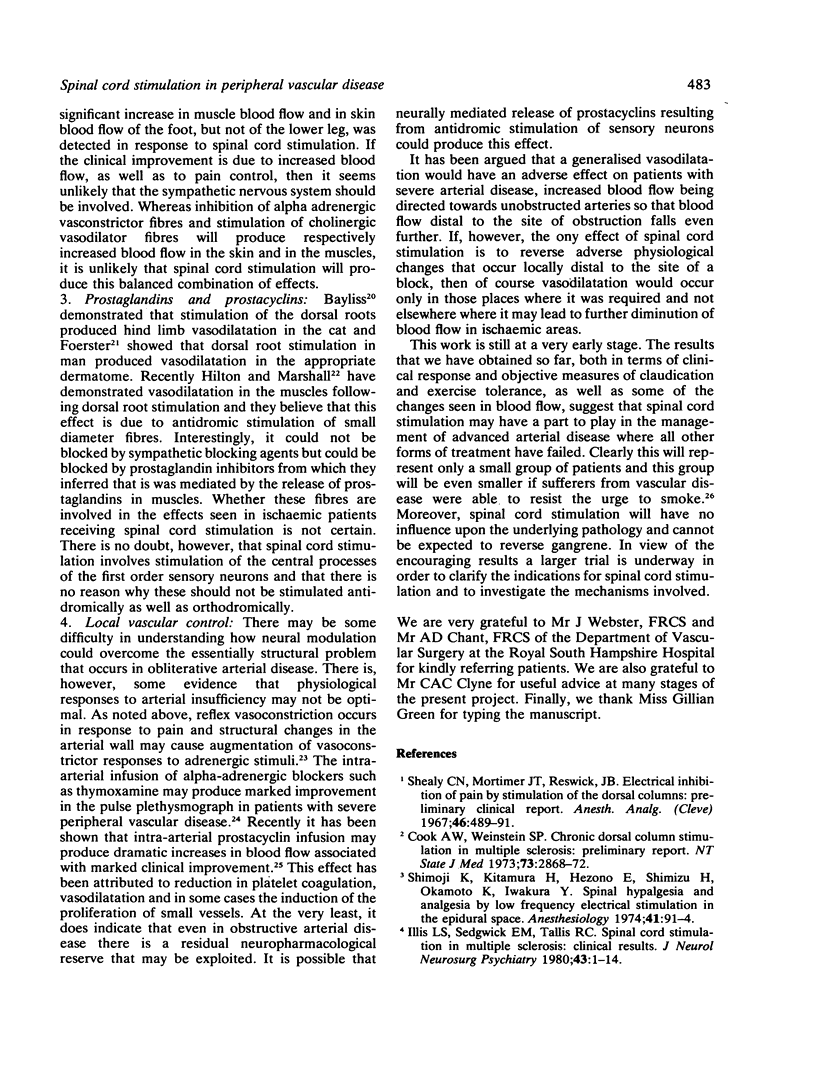Abstract
The results of ten patients with severe, intractable symptoms of arterial disease receiving spinal cord stimulation are reported. Six out of ten patients showed clinical improvement. Three of five patients with severe rest pain obtained complete or very marked relief and one of two patients with moderate rest pain in the legs obtained complete relief. The mean claudication distance in the ten patients increased from 65 to 212 metres during epidural stimulation of the spinal cord. Exercise tolerance as measured on a bicycle ergometer increased by 61%. These changes were associated with small increases in cutaneous and muscle blood flow. In those patients who responded clinically, the improvements seen were maintained as long as spinal cord stimulation was continued. There was no clinical response to transcutaneous (placebo) stimulation and four patients did not respond in any way to spinal cord stimulation. The improvements seen are unlikely to be due to either the natural history of the disease or to a placebo effect. The effect is probably due to antidromic stimulation of the central processes of the first order sensory neurons. It is suggested on the basis of animal studies that this effect may be mediated by release of prostaglandins as well as indirectly via pain relief.
Full text
PDF






Selected References
These references are in PubMed. This may not be the complete list of references from this article.
- Abram S. E., Asiddao C. B., Reynolds A. C. Increased skin temperature during transcutaneous electrical stimulation. Anesth Analg. 1980 Jan;59(1):22–25. [PubMed] [Google Scholar]
- Abram S. E. Increased sympathetic tone associated with transcutaneous electrical stimulation. Anesthesiology. 1976 Nov;45(5):575–577. [PubMed] [Google Scholar]
- Bayliss W. M. On the origin from the spinal cord of the vaso-dilator fibres of the hind-limb, and on the nature of these fibres. J Physiol. 1901 Feb 28;26(3-4):173–209. doi: 10.1113/jphysiol.1901.sp000831. [DOI] [PMC free article] [PubMed] [Google Scholar]
- Cook A. W., Oygar A., Baggenstos P., Pacheco S., Kleriga E. Vascular disease of extremities. Electric stimulation of spinal cord and posterior roots. N Y State J Med. 1976 Mar;76(3):366–368. [PubMed] [Google Scholar]
- Cook A. W., Weinstein S. P. Chronic dorsal column stimulation in multiple sclerosis. Preliminary report. N Y State J Med. 1973 Dec 15;73(24):2868–2872. [PubMed] [Google Scholar]
- Ebersold M. J., Laws E. R., Jr, Albers J. W. Measurements of autonomic function before, during, and after transcutaneous stimulation in patients with chronic pain and in control subjects. Mayo Clin Proc. 1977 Apr;52(4):228–232. [PubMed] [Google Scholar]
- Folkow B. The haemodynamic consequences of adaptive structural changes of the resistance vessels in hypertension. Clin Sci. 1971 Jul;41(1):1–12. doi: 10.1042/cs0410001. [DOI] [PubMed] [Google Scholar]
- Hawkes C. H., Myke M., Desmond A., Bultitude M. I., Kanegaonkar G. S. Stimulation of dorsal column in multiple sclerosis. Br Med J. 1980 Mar 29;280(6218):889–891. doi: 10.1136/bmj.280.6218.889. [DOI] [PMC free article] [PubMed] [Google Scholar]
- Hilton S. M., Marshall J. M. Dorsal root vasodilatation in cat skeletal muscle. J Physiol. 1980 Feb;299:277–288. doi: 10.1113/jphysiol.1980.sp013124. [DOI] [PMC free article] [PubMed] [Google Scholar]
- Hughson W. G., Mann J. I., Tibbs D. J., Woods H. F., Walton I. Intermittent claudication: factors determining outcome. Br Med J. 1978 May 27;1(6124):1377–1379. doi: 10.1136/bmj.1.6124.1377. [DOI] [PMC free article] [PubMed] [Google Scholar]
- Illis L. S., Sedgwick E. M., Tallis R. C. Spinal cord stimulation in multiple sclerosis: clinical results. J Neurol Neurosurg Psychiatry. 1980 Jan;43(1):1–14. doi: 10.1136/jnnp.43.1.1. [DOI] [PMC free article] [PubMed] [Google Scholar]
- Jobling D. T., Tallis R. C., Sedgwick E. M., Illis L. S. Electronic aspects of spinal-cord stimulation in multiple sclerosis. Med Biol Eng Comput. 1980 Jan;18(1):48–56. doi: 10.1007/BF02442479. [DOI] [PubMed] [Google Scholar]
- Jonason T., Jonzon B., Ringqvist I., Oman-Rydberg A. Effect of physical training on different categories of patients with intermittent claudication. Acta Med Scand. 1979;206(4):253–258. doi: 10.1111/j.0954-6820.1979.tb13506.x. [DOI] [PubMed] [Google Scholar]
- Read D. J., Matthews W. B., Higson R. H. The effect of spinal cord stimulation on function in patients with multiple sclerosis. Brain. 1980 Dec;103(4):803–833. doi: 10.1093/brain/103.4.803. [DOI] [PubMed] [Google Scholar]
- Rose S. S. The use and abuse of vasodilator drugs. Vasc Dis. 1967 Apr;4(2):67–82. [PubMed] [Google Scholar]
- Shealy C. N., Mortimer J. T., Reswick J. B. Electrical inhibition of pain by stimulation of the dorsal columns: preliminary clinical report. Anesth Analg. 1967 Jul-Aug;46(4):489–491. [PubMed] [Google Scholar]
- Shimoji K., Kitamura H., Ikezono E., Shimizu H., Okamoto K., Iwakura Y. Spinal hypalgesia and analgesia by low-frequency electrical stimulation in the epidural space. Anesthesiology. 1974 Jul;41(1):91–94. doi: 10.1097/00000542-197407000-00026. [DOI] [PubMed] [Google Scholar]
- Szczeklik A., Nizankowski R., Skawinski S., Szczeklik J., Gluszko P., Gryglewski R. J. Successful therapy of advanced arteriosclerosis obliterans with prostacyclin. Lancet. 1979 May 26;1(8126):1111–1114. doi: 10.1016/s0140-6736(79)91792-6. [DOI] [PubMed] [Google Scholar]


